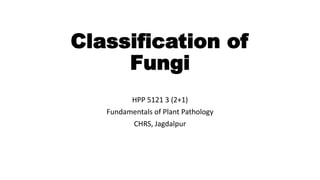
Classification of fungi
- 1. Classification of Fungi HPP 5121 3 (2+1) Fundamentals of Plant Pathology CHRS, Jagdalpur
- 2. • The fungi are a group of eukaryotic, non-vascular organism. Which are of diverse forms, sizes, physiology and reproduces both by sexual (meiotic) and asexual (mitotic) spores. • Examples of fungi :-Mushrooms, yeasts, molds, Penicillium- the first of the wonder drugs, penicillin, was isolated from this fungus and crop parasites. • Fungi are most often associated with the roots of some plant species, and this type of symbiotic associations is known as mycorrhizae. • The study of fungi is known as mycology (Mykes = mushroom + logos = discourse) or mycetology and who study about fungus is known as mycologist.
- 4. • British mycologist, GC Ainsworth (1905-1998) was former director, Commonwealth Mycological Institute. His scheme of classification was considered as an ideal one that reflected natural relationships. • In this scheme, the fungi were divided into two Divisions. • Fungi with plasmodium or pseudoplasmodium were classified in the Division Myxomycota, whilst the majority of fungi, which were filamentous, were classified in the Division Eumycota.
- 5. • Based on the presence or absence of Plasmodium and pseudoplasmodium; the kingdom Mycota is further divided into two divisions: • Myxomycota i.e., slime molds and Eumycota or true fungi. • Divisions, ends in mycota are subsequently divided into subdivision- mycotina, class- mycetes, subclass- mycetidae, order- ales, Family- aceae.
- 9. • Important features: i. Free-living, parasitic or mutualistic symbionts, devoid of chlorophyll. ii. Cell wall composition is very variable, majority contain chitin and glucan. iii. Reserve food materials are oil, mannitol and glycogen. iv. Except some unicellular members, majority are filamentous.
- 10. DIVISION- MYXOMYCOTA • Wall-less organisms possess either a Plasmodium (a mass of naked multinucleate protoplasm having amoeboid movement) or a pseudoplasmodium (an aggregation of separate amoeboid cells). • Both are of slimy consistency, hence slime molds. 1. Class- Acrasiomycetes (cellular slime molds) 2. Class- Hydromyxomycetes (net slime molds) 3. Class- Myxomycetes (true slime molds) 4. Class- Plasmodiophoromycetes (endo- parasitic slime molds).
- 11. DIVISION EUMYCOTA • (TRUE FUNGI, ALL WITH WALLS) • Thallus is typically filamentous with cell wall. Plasmodium absent. Five subdivision 1. Mastigomycotina 2. Zygomycotina 3. Ascomycotina 4. Basidiomycotina 5. Deuteromycotina
- 12. The important characteristics of Mastigomycotina are: i. The subdivision Mastigomycotina is commonly known as zoosporic fungi ii. Members of this group vary from unicellular plant body (with or without rhizoid) to filamentous coenocytic mycelium. iii. Sexual reproduction takes place by gametic copulation, gametangial copulation and gametangial contact Key to classes of Mastigomycotina: A. Class- Chitridiomycetes B. Class- Hypochitridiomycetes C. Class- Oomycetes
- 13. Some important parasitic members of this group are: • Pythium. Different species of Pythium cause foot rot, fruit rot, rhizome rot and damping off. • Phytophthora. Different species of Phytophthora cause stem and leaf blight, foot rot, leaf rot, corm rot, fruit rot etc. • Albugo. Different species of Albugo cause white rust disease of different hosts like crucifers (cabbage, Brassica, radish, turnip etc.
- 15. The Important Characteristics • The fungi belonging to this group are generally terrestrial and they produce zygospore (Gr. zygos — yoke; Spora — seed, spore) after sexual reproduction. • The thallus is normally haploid, consisting of coenocytic mycelium and its cell wall contains chitin. • Asexual reproduction takes place by aplanospores. • Sexual reproduction takes place by gametangial copulation, resulting in the formation of zygospore. .
- 16. two classes: i. Zygomycetes, ii. Trichomycetes Some important parasitic members of this group are:
- 18. • The Ascomycotina (Gr. askos— sac or bladder; mykes — fungi), commonly known as “sac fungi”, is the largest group under the Kingdom Fungi, comprised of six classes and about 30,000 species. • live in salt, freshwater and terrestrial habitats. • Vegetative body is unicellular or commonly well-developed, branched septate mycelium with uni or multinucleate cells having perforated septa. six classes, namely: i. Hemiascomycetes, ii. Loculoascomycetes, iii. Plectomycetes, iv. Laboulbeniomycetes, v. Pyrenomycetes, vi. Discomycetes.
- 19. Some important parasitic members of this group are: • Its includes morels, powdery mildews, yeasts and cup fungi
- 21. • The subdivision included about 500 genera with more than 16,000 species. • Basidiomycotina are characterized by the formation of basidiospores and absence of flagellated structure. Three classes 1 Teliomycetes 2 Hymenomycetes 3 Gasteromycetes
- 22. Some important parasitic members of this group are: • The members include rusts, smuts, mushrooms, puff balls, toad stools, bracket fungi etc. Rust (Puccinia spp.) and smuts (Ustilago spp.)
- 24. • The subdivision Deuteromycotina is also known as Fungi imperfecti or Waste Box Fungus, due to lack of knowledge on sexual reproduction. • C. T. Ingold called Deuteromycotina the “dust bin” group because of their doubtful systematic position. • Its include about 600 genera and over 20,000 species. • Members are not closely related and are not necessarily similar in structure or appearance; do not share a common ancestry
- 25. Some important parasitic members of this group are: • Leaf spot of curcifers, Early blight of potato, Brown spot of rice, Tikka or Leaf spot of groundnut
- 26. Life cycle of Alternaria
- 27. Thank you
